The awful news about the murder of Costa Rican sea turtle conservationist Jairo Mora Sandoval has shocked the world. Jairo was a brave young conservationist working hard to protect an important leatherback turtle nesting beach called Moin Beach, near the port city of Limon on the Caribbean coast. The beach was well-known both as a place for poachers to collect turtle eggs and a key location for drugs to enter Costa Rica. Along with Jairo, four volunteers from the US and Spain were locked into an abandoned house and robbed (they later escaped unharmed).
Many people come to Costa Rica’s beaches each year to see sea turtles nesting or to volunteer with conservation programs. These visitors and volunteers are critical to the success of local organizations, providing both manpower and funding to continue their work. We connect more than 100 people each year to turtle projects with no incidents. With this recent news, many people now want to know whether it’s safe to go to Costa Rica.
Most of the country’s beaches do not face the danger that exists at Moin Beach. The majority of turtle nesting beaches in the country are remote with few people living nearby and are not used for transporting drugs. While poaching exists across the country due to a lack of enforcement by government authorities, in most places the people that collect the eggs do so away from researchers and conservationists that patrol the beaches. It’s rare for a poacher to confront a conservationist and most turtle projects have safety measures in place to make sure that the beaches are safe and only Costa Ricans interact with local residents on the beach at night.
Costa Rica’s sea turtles need the help of volunteers and tourists now more than ever. It’s always a good idea to check with the organizations that run the conservation programs to see what safety measures they have in place and what the current situation is as well as with the State Department (link below). One thing to keep in mind is whether the beach is part of a protected area; in some cases those beaches have more personnel on the beach. We are confident that the beaches where we send people are safe and would not put anyone in danger by organizing a trip or recommending a place that might not be safe.
SEE Turtles is working with a coalition of organizations to respond to this tragedy by offering a reward for information leading to the arrest of the killers, creating a memorial fund to support Jairo’s family and create a national park in his name, and to put pressure on the Costa Rican government to respond to this crime and ensure the safety of all nesting beaches. For more information, check out the resources below.
By Brad Nahill
Director & Co-Founder
SEEtheWILD & SEE Turtles
Helpful resources:
US State Department Travel Page (Costa Rica)
The Legacy of Jairo Mora Sandoval
Washington Post article on Jairo’s murder
Memorial Fund for Jairo Mora Sandoval
Petition to the Costa Rican government
SEE Turtles Statement on the Death of Jairo Mora Sandoval
Lisa Jo Randgaard, a longtime Sea Turtle Conservancy member, passed away unexpectedly in May 2012, at age 43, due to complications from a serious congenital heart condition. To honor Lisa’s passion for wildlife and its protection, especially her love of sea turtles, the Randgaard family established The Lisa Jo Randgaard Fund, making it STC’s first member-initiated endowment fund.
This March, Lisa’s family launched Lisa’s  Fundanas Project. Her mother and two sisters are hand-sewing special, limited edition bandanas using batik cotton fabric featuring a beautiful sea turtle print. Each bandana is approximately 21”x 21” and comes with a special label reading “Handmade for a Sea Turtle Hero” and a turquoise sea turtle bead. Custom, pet-sized Fundanas without beads are also available, and can be embroidered with your pet’s name.
Fundanas Project. Her mother and two sisters are hand-sewing special, limited edition bandanas using batik cotton fabric featuring a beautiful sea turtle print. Each bandana is approximately 21”x 21” and comes with a special label reading “Handmade for a Sea Turtle Hero” and a turquoise sea turtle bead. Custom, pet-sized Fundanas without beads are also available, and can be embroidered with your pet’s name.
 The minimum donation for each Limited Edition Lisa’s Fundana is $20 ($10 or more for pets), and 100% of all money raised is donated to STC for The Lisa Jo Randgaard Fund. To celebrate Lisa’s love of travel, the family is asking all Fundanas fans to share pictures of themselves and pets wearing their Fundanas on both local and global adventures. Pictures can be added to the growing album at LoveIntoSustainedAction.com and Love Into Sustained Action on Facebook.
The minimum donation for each Limited Edition Lisa’s Fundana is $20 ($10 or more for pets), and 100% of all money raised is donated to STC for The Lisa Jo Randgaard Fund. To celebrate Lisa’s love of travel, the family is asking all Fundanas fans to share pictures of themselves and pets wearing their Fundanas on both local and global adventures. Pictures can be added to the growing album at LoveIntoSustainedAction.com and Love Into Sustained Action on Facebook.
“Lisa saw bandanas as an important accessory, whether she was traveling, cooking or just hanging out at home,” remembers her mom. “We saw an opportunity to raise money for her new fund in a creative and purposeful way. Lisa’s Fundanas Project matches her great sense of fun and works to protect sea turtles, which she cared about deeply.'”
To get more information on Lisa’s Fundanas Project and to place an order, please visit LoveIntoSustainedAction.com. Orders will be taken through March 2014.
Celebrate World Sea Turtle Day with Sea Turtle Conservancy (STC) at the Florida Museum of Natural History! Children and families are invited to tour the museum’s sea turtle exhibits with staff from Sea Turtle Conservancy. These expert-led “Turtle Tours” are a great way to learn about sea turtles and their habitat. Kids will also create fun turtle crafts to take home, meet sea turtle scientists, and play turtle trivia for a chance to win a cool prize. Researchers from the Archie Carr Center for Sea Turtle Research at UF will be there from 2 – 4 pm to answer questions about sea turtle conservation and careers in marine biology. The event features sea turtle specimens, a turtle library, and free stickers and 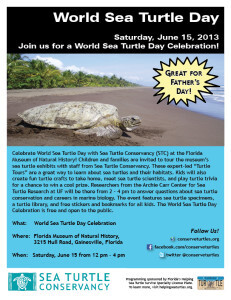 bookmarks for all kids. The World Sea Turtle Day Celebration is free and open to the public.
bookmarks for all kids. The World Sea Turtle Day Celebration is free and open to the public.
What: World Sea Turtle Day Celebration
Where: Florida Museum of Natural History
3215 Hull Road, Gainesville, Florida
When: Saturday, June 15 from 12 pm – 4 pm
After a recent presentation at an elementary school, STC’s research and technology specialist Dan Evans received a bundle of letters from the students thanking him for his talk about sea turtles. Here is one letter with artwork from Matthew, Dan’s “No.1 fan!”
Thank you for teaching us about turtles! I have learned so much from you! Your presentation was awesome! Can’t wait for the Tour de Turtles! You are awesome Mr. Evans!
From your No. 1 fan,
Matthew B.
PS: keep an eye on Sheldon
Sea Turtle Conservancy (STC) has received two grants awarded by Florida’s Sea Turtle Grants Program in support of two educational programs: Distance learning and the Tour de Turtles.
The first grant supports STC’s development of a sea turtle distance learning program that is scheduled to go live in Spring 2014. This project will allow STC to reach the next generation of technology-savvy students through high-quality educational programming to increase student awareness about sea turtles and marine conservation with the goal of creating an informed, proactive youth that will support sea turtle conservation and become environmental stewards.
The second grant helps STC continue the Tour de Turtles Educational Program through 1) developing new lesson plans for the Elementary, Middle and High School levels based upon satellite tracking and issues related to Florida’s sea turtles and habitats; 2) working with the University of Central Florida to deploy satellite transmitters on four post-nesting adult loggerhead and/or green sea turtles in and around the Carr Refuge as part of the 2013 Tour de Turtles; and 3) developing new educational multimedia material for the Tour de Turtles website.
These grants are supporting critical programs that are increasing knowledge about sea turtles and providing solutions to ensure their survival. The grants were made possible by the sale of the “Helping Sea Turtles Survive” specialty license plate, which funds Florida’s Marine Turtle Protection Program and the Sea Turtle Grants Program. To learn more, visit www.helpingseaturtles.org.
Sea Turtle Conservancy (STC) & Wells Fargo volunteers kicked off sea turtle nesting season by restoring native dune habitats for sea turtles and other coastal wildlife at the Archie Carr National Wildlife Refuge in Melbourne Beach.
 STC received a grant from Wells Fargo-National Fish and Wildlife Foundation in March to support its sea turtle lighting and dune restoration initiatives in Florida, home to 90 percent of all sea turtle nesting in the United States.
STC received a grant from Wells Fargo-National Fish and Wildlife Foundation in March to support its sea turtle lighting and dune restoration initiatives in Florida, home to 90 percent of all sea turtle nesting in the United States.
Nesting turtles once had no trouble finding a dark beach on which to nest, but now they  compete with tourists, businesses and coastal residents for use of Florida’s beaches. Artificial lights from these developments discourage female turtles from coming ashore to nest and cause turtle hatchlings to become disoriented away from the ocean toward beachfront properties. In addition, coastal development can negatively impact the health of beach dune systems,
compete with tourists, businesses and coastal residents for use of Florida’s beaches. Artificial lights from these developments discourage female turtles from coming ashore to nest and cause turtle hatchlings to become disoriented away from the ocean toward beachfront properties. In addition, coastal development can negatively impact the health of beach dune systems,  decreasing the quality of sea turtle nesting habitat and destabilizing beaches for turtles and residents alike.
decreasing the quality of sea turtle nesting habitat and destabilizing beaches for turtles and residents alike. 
STC is working with beachfront, multi-family properties in Florida to retrofit exterior lighting using the latest turtle-friendly, energy-efficient technology. Additionally, STC is coordinating with property owners to restore dune habitat for sea turtles and other wildlife to provide an additional buffer to shield beach habitat from unwanted lights.
More than 25 Wells Fargo volunteers were on hand to help restore the dunes at Windsong Condominiums, located on a critically-eroding section of the Archie Carr National Wildlife Refuge, by planting native dune vegetation that withstands salty air and strengthens dunes with their extensive root systems. Paula Bernston, a native plant expert with Brevard County Natural Resources, was there to ensure that volunteers were trained to properly space and plant the vegetation. Volunteers planted 1000 sea oats, 120 railroad vines, 180 beach elders and 200 spartina patens.
In addition, STC lighting specialist Karen Shudes worked with the condominium to correct problematic lights adjacent to the restored dune by installing turtle-friendly, red LED light fixtures. This collaborative project restored approximately 300 feet of nesting habitat for sea turtles and their hatchlings.
Today is Earth Day! To celebrate our planet’s wildlife and habitats, STC has a few easy ways you can go a little greener…
Help save sea turtles by making a donation this Mother’s Day in honor of your mother or another special woman in your life.
For every tax-deductible donation of $10 or more made in honor of a mother in the month of April, the honored mother will be entered for a chance to win a beautiful gold sea turtle charm and necklace from altruette.
With her honorary donation, your mom will receive a personalized letter, a sea turtle sticker, a membership window cling, and a one-year subscription to STC’s membership publication.
To honor your mom this Mother’s Day and enter her for a chance to win altruette’s sea turtle charm and bracelet, visit www.conserveturtles.org/honoryourmom.
All donations must be received by Tuesday, April 30 at noon to help ensure delivery by Mother’s Day.
Your donation enables us to continue our mission to to ensure the survival of sea turtles through research, education, training, advocacy and protection of their natural habitats.
Enrollment is now open for Sea Turtle Conservancy’s annual Eco-Explorers “Ocean Motion and Much More!” summer camps for children ages 9 to 15.
These week-long, day camps will be offered in June at the Barrier Island Center, located in the heart of the Archie Carr National Wildlife Refuge in beautiful Melbourne Beach, Florida
The Eco-Explorers summer camps provide a special opportunity for children to explore diverse lagoon life, the world beneath the sea, and the beach at the Archie Carr National Wildlife Refuge, which attracts the most nesting sea turtles in the US!
At Eco-Explorers summer camps, children make special connections with ocean and lagoon habitats and wildlife, while sharing fun adventures on the water such as snorkeling, kayaking, paddle boarding and surfing.
The program cost of $290 per week includes transportation, certified aquatic instructors, equipment, a t-shirt and a guided sea turtle walk with preferred reservation.
Click here to learn more and download the“Ocean Motion & Much More!” Eco-Explorers enrollment kit.
For more information contact Donna Lee Crawford at donnalee@conserveturtles.org.
We look forward to exploring the ocean together this summer!
In 1956, Dr. Archie Carr started the global movement to protect sea turtles with his book The Windward Road: Adventures of a Naturalist on Remote Caribbean Shores. The book follows Dr. Carr on a fantastic journey through the Caribbean in search of green turtle nesting beaches. When it was first published, the book sparked an international interest in the conservation of sea turtles and led to the founding of the “Brotherhood of the Green Turtle,” today known as the nonprofit Sea Turtle Conservancy.
The amazing history of sea turtles and the culture of the Caribbean are portrayed through Dr. Carr’s humorous and delightful writing in a way that both scientists and laypeople can appreciate. The Windward Road entertains, instructs and drives people to action, a combination that has led to the success of the book and inspired many to join the movement to save the green sea turtle.
A revised edition of The Windward Road was published this year. The new edition includes a forward by David Godfrey, the Executive Director of Sea Turtle Conservancy. David, like countless other conservationists, was deeply influenced by Dr. Carr’s writing and infectious love and passion for sea turtles and all other creatures.
Almost everyone working in the field of sea turtle or marine conservation today has been in some way affected by Dr. Carr’s teachings and writings. Sea Turtle Conservancy is proud to carry on Dr. Carr’s legacy and to continue the work he began 57 years ago with The Windward Road.
To purchase the revised edition of The Windward Road, visit STC’s online Gift Shop!
Weibel Family Vineyards of Lodi, CA, and Sea Turtle Conservancy have joined forces to raise awareness and support for the protection of threatened and endangered sea turtles with the release of “Sea Turtle Reserve Red” and “Sea Turtle Reserve White” wines.
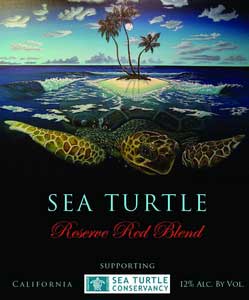 The winery is offering the special-edition Sea Turtle Selections, with a portion of all proceeds being donated to Sea Turtle Conservancy (STC). Based in Florida, STC is a global leader in the study and protection of sea turtles and their important nesting beaches.
The winery is offering the special-edition Sea Turtle Selections, with a portion of all proceeds being donated to Sea Turtle Conservancy (STC). Based in Florida, STC is a global leader in the study and protection of sea turtles and their important nesting beaches.
Although California wines and sea turtles may seem to have little in common, Fred Weibel, winemaker and owner of Weibel Family Vineyards, is a long-time sea turtle enthusiast and wants to give something back to help protect these magnificent marine animals.
“We wanted to bring attention to the many survival challenges sea turtles face” Weibel said. “They are truly beautiful creatures that play important roles in our marine and coastal environments. Hopefully we all can do our part to make sure sea turtles are around for future generations.” Weibel added. “Our main goal in producing the Sea Turtle brand of wines is to make and promote a product that helps raise much-needed financial support for sea turtle protection, conservation and education programs in our coastal regions.”
STC executive director David Godfrey said, “Our organization is very proud of its partnership with Weibel Family Vineyards. The revenue generated from these specialty sea turtle wines will help save sea turtles in Florida and elsewhere.”
“Sea Turtle Reserve Red and Reserve White” labels feature  beautiful sea turtle illustrations by renowned Florida artist Damien Share. Godfrey stated, “Damien’s inspiring sea turtle paintings, which were donated by the artist, provide a focal point for the uniquely crafted label designs on these two new wines. Anyone who cares about sea turtles or marine wildlife will immediately be drawn to these special wines.”
beautiful sea turtle illustrations by renowned Florida artist Damien Share. Godfrey stated, “Damien’s inspiring sea turtle paintings, which were donated by the artist, provide a focal point for the uniquely crafted label designs on these two new wines. Anyone who cares about sea turtles or marine wildlife will immediately be drawn to these special wines.”
Weibel Family Vineyards is using selected varietal blends in crafting the two Sea Turtle wine selections. These particular ‘easy styled’ blends offer broad appeal and have been very popular with a large number of restaurants throughout the Bay area of California.
‘Sea Turtle Wines’ has teamed with Western Wine Merchants (Orlando, FL) and is available at the following locations in Florida:
Tim’s in Ponte Vedra – 904-686-1741
Tim’s in St. Augustine – 904-461-0060
Petty’s Meat Market in Melbourne (Babcock) – 321-725-0400
Petty’s Meat Market Melbourne (Wickham) – 321-752-0400
Cork and Olive in Altamonte Springs – 407-622-7814
Roy’s Liquor and Fine Wines in Ft. Pierce – 772-471-3097
Yours Truly in Daytona Beach – 386-547-7189
In nature, I can quiet my mind, and observe the color, sounds, and rhythm of life as it naturally unfolds, bringing me closer to the divine and the cosmos. Unfortunately my fast paced life juggling career, parenting and home ownership limits my experience in nature. At the same time, my desire for awe inspiring earth connections becomes stronger.
Embracing this need, I travelled to a small village nestled between a massive rain forest and the calm temperate Caribbean Sea. Tortuguero, Costa Rica known affectionately as the Land of the Turtles inhabits key nesting grounds for four endangered species of sea turtles (Loggerhead, Leatherback, Green, and Hawksbill). In the land of the turtles there are no high rise condos, beach front properties, casinos, or chain stores – just endless charcoal sandy beaches, that embrace a night sky filled with brightly lit stars. It was the first time in my life the night sky visibly illuminated abundance, infinity and depth, and spoke to me without words. I wondered did the darkness improve the nesting and hatching habitats for Costa Rican sea turtles. If the answer is “yes” how can densely populated beach fronts with artificial light continue to be critical habitats for sea turtles? Have we shifted our balance with the earth and interrupt the natural patterns of darkness and light?
Here in the United States, the National Oceanic and Atmospheric Administration’s (NOAA) National Marine Fisheries Service is responsible for the stewardship of the nation’s living marine resources and their habitat. In their Recovery Plans for Endangered Species, they identified light pollution as a serious threat to sea turtles populations. Specifically, NOAA targeted highly developed and populous coastal communities that rely on artificial light as a major obstacle to sea turtle recovery efforts. Light pollution is of critical importance for the state of Florida, which hosts 90% of all sea turtle nesting in the United States.
Coastal lights not only discourage female turtle to come ashore and nest but disorient hatchlings, causing them to crawl inland, away from the ocean or wander aimlessly on the beach. Disoriented hatchlings often die from dehydration, exhaustion, terrestrial predation and even passing cars. If they make it to the ocean, they have a lower chance of survival due to energy loss, making it harder to reach important off-shore habitats and increasing their susceptibility to marine predators.
As a result, the State of Florida with assistance from by the National Fish and Wildlife Foundation’s Recovered Oil Fund for Wildlife, (Based on BP 2010 Oil Spill and Recovery) is working with local officials and property owners to darken nesting beaches with chronic lighting problems. This important project is being implemented by the Sea Turtle Conservancy (STC) through funding property owners for the installation of “turtle friendly” lighting. STC’s primary focus in on balancing safety and visibility needs of the community with sea turtle nesting habit. STC adheres to a simple approach, promoting the following three steps:
1. Keep it low by removing tall light fixture lamped with white light and replacing them with Amber LED Bollard Fixtures no greater than 42″ in height.

2. Keep it shielded by removing tall spotlight lamped with white light with shielded downward fixtures with Red or Amber LED light. (Sea turtles are not drawn to or attracted to Red or Amber light due to a longer wave length).

3. Keep it long wavelength; Sea Turtles are HIGHLY ATTRACTED to short wavelengths of light and are less disturbed by long wavelengths of light.

STC recognizes to mitigate the negative impacts of light pollution will require the behavior change of local government, owners, renters, tourists, and businesses. STC continues to work with private beachfront property owners to retrofit problem lights using the latest sea turtle-friendly technologies. To date, STC has worked with over 70 existing coastal properties-many with histories of sea turtle disorientation. STC goal is to extend existing stretches of dark beach to create a contiguous stretch of nesting habitat. When all projects are complete, STC will have darkened 69,000 feet of beachfront and restored over 9 miles of sea turtle nesting habitat to darkness.

Ann Maria Island lies on the Southwest Coast of Florida. Over a five year period, 5,000 hatchlings were disoriented and never made it to the ocean. STC worked with 7 properties, to retrofit properties. As a result, in 2011 there were no reports of sea turtle disorientation. Marine turtle permit holders authorized by the State of Florida were responsible for collecting data.
Sea turtles represent a time on earth when dinosaurs reigned over 200 million years ago. Often referred to as key indicator species their condition reflects the health of our oceans and planet. Their survival is directly tied to our existence. Sea turtles face numerous threats from pollution, loss of habitat and long haul fishing techniques but coastal light pollution is one threat easy to change. Not only does this successful project restore the balance of light and darkness to the beaches of Florida but improves the lives of these majestic creatures. Information on the Sea Turtle Conservancy is located at: www.conserveturtles.org.
Guest blog post by Natalie Hummel
First appeared on Earth Times on Mar. 11, 2013.
One of our AdvoKids, Cori McWilliams, was selected as a Wyland Foundation Youth Ambassador for the Planet for her dedication to protecting sea turtles. This award is presented to hardworking kids who strive to help the planet. Cori has volunteered with Sea Turtle Conservancy’s AdvoKids program for more than 2 years.
For one of her projects, she created a sea turtle book read-a-thon fundraiser at her school. The read-a-thon lasted three weeks, and Cori was able to raise $72. She also led educational presentations about sea turtles for second grade classes at her school and has participated in several beach clean-ups. And recently, she became an official volunteer at the Barrier Island Center.
This past week, Cori’s school invited her to continue hosting sea turtle presentations to the second-grade classes at her school. In addition to the presentations, she handed out educational information about sea turtles and encouraged her peers to get more involved.
“Between being a ‘big third grader’ and also being a sea turtle AdvoKid, the 2nd graders pretty much pushed Cori into rock stardom!” said Cori’s mom, Celeste McWilliams, who also volunteers for Sea Turtle Conservancy.
Keep up the amazing work Cori!
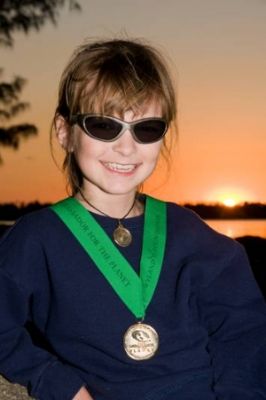
Cori wearing her Youth Ambassador for the Planet Medal
Last week, Sea Turtle Conservancy staff participated in the 33rd Annual International Sea Turtle Symposium in Baltimore, Maryland. More than 1,000 experts from 60 countries gathered to discuss and share the latest news regarding sea turtle research, conservation, and policy.
Each year, the president of the symposium recognizes one individual for their outstanding contributions to sea turtles. This year, STC’s Marydele Donnelly, Director of International Policy, received the ISTS President’s Award for her 25 years of effective work in recovering the world’s sea turtle populations.
Marydele’s accomplishments are too many to list, but there are three career highlights that helped earn her the President’s Award.
–Marydele was instrumental in the establishment of the Archie Carr National Wildlife Refuge in Florida, site of the largest nesting beach in the United States.
–Marydele played a vital role in lobbying for Turtle Excluder Devices to be required on shrimp boats.
–She was also a major player in the establishment of the Marine Turtle Conservation Act by congress, which provides funding for sea turtle conservation internationally.
At the award banquet, Marydele accepted her award with some emotional comments about her life’s work and her friendships within the sea turtle community. Marydele noted that she first fell in love with sea turtles when she visited Tortuguero, Costa Rica, explaining that for this reason it is particularly rewarding for her to be with Sea Turtle Conservancy during this phase of her career.
Congratulations Marydele on behalf of Sea Turtle Conservancy. We are proud and lucky to have you on our team!

From left to right: Laura Forte (STC Board President), David Godfrey (STC Executive Director), Marydele Donnelly (Director of International Policy), Dr. Ray Carthy (ISTS President)
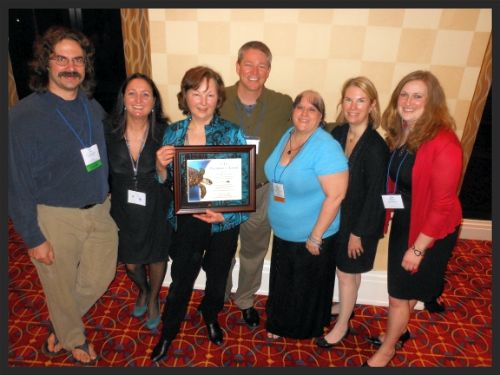
From left to right: Daniel Evans (STC Research and Technology Specialist), Dr. Emma Harrison (STC Scientific Director), Marydele Donnelly (Director of International Policy), David Godfrey (STC Executive Director), Merna Wimsatt (STC Membership Coordinator), Laura Forte (STC Board President), Claire Atkinson (former STC Research Coordinator)
The southern Atlantic shores of the United States are highly vulnerable to sea level rise, which could be devastating for sea turtles. Gary Appelson, policy director at the Sea Turtle Conservancy in Florida, says that “sea level rise is one of the biggest threats” facing sea turtles.
Along Florida’s central Atlantic Coast, parts of the region could see a 49 to 80 percent decline in the area of ocean beach with just a 15-inch rise in sea level, which is well within the range projected during this century.
Unhindered, beaches would naturally migrate inland. But “in Florida, the beachfront development line means that the beach cannot move inland as it would naturally,” Appelson says. People try to protect ocean front properties by building sea walls, “but this only increases the erosion around them and has devastating impacts on turtles and their nesting habitat.” Florida has “the most aggressive beach renourishment program in the country” and spends tens of millions of dollars every year adding sand to the beach. This is economically unsustainable because “the cost of doing this in perpetuity will be unbelievable.”
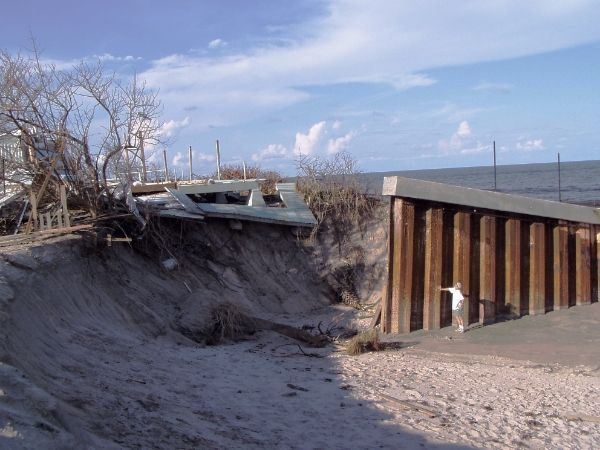
STC’s Gary Appelson standing in front of an exposed sea wall in Brevard County after a hurricane.
Florida’s beaches host 90 percent of all the sea turtle nesting in North America, as well as approximately 80 million tourists every year.172 Sea level rise is already a problem. “The beaches are eroding, Appelson says. ”They have been eroding for decades.” Furthermore, sea turtles “depend on the in-shore marine environment” of barrier islands, bays and inlets. “Sea turtles use in-shore grass beds for extensive foraging habitat and depend on near-shore reefs for refuge. And they come from all over. Sea turtles leave their nesting areas far, far away to come to Florida’s grass beds.” These critical habitats will also be impacted by rising seas and increasing temperatures.
“Florida’s beaches are ground zero for sea level rise,” says Appelson, posing a huge threat not only to sea turtles but to Florida’s coastal economy and residents. “One of the most important things we can do to protect sea turtles, and people, is to reform coastal management… to incorporate climate change and sea level rise into planning, in addition to reducing carbon emissions.”
This is an excerpt from National Wildlife Federation’s report Wildlife in a Warming World: Confronting the Climate Crisis. To read the full report, click here.